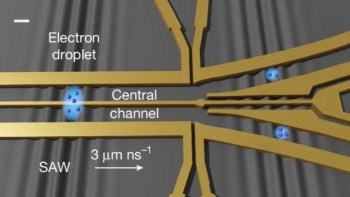
A new kind of phase separation that occurs when self-propelled particles are subject to torque has been discovered by researchers in South Korea and the US. Steve Granick and his team at the Ulsan National Institute of Science and Technology have pioneered the use of synthetic “Janus” nanoparticles to study the phase behaviour of nonequilibrium systems. Teaming up with theorists at Princeton University, they show in a paper published in Nature Physics, that the phase separation of these particles is driven by orientational ordering, making it distinct from other nonequilibrium systems.
Systems of self-propelled – or “active” – particles have a unique phase behaviour because they exist out of equilibrium. Perhaps the most intriguing of these behaviours is that active particles can phase separate into a liquid and gas phase even if the particles repel each other, in a phenomenon called motility induced phase separation (MIPS). As Granick describes, “It’s like if cars steered toward crowded areas and made the crowd even bigger without attracting each other”. Active matter research was transformed by the discovery of MIPS, but Granick’s team have found that it is not the only way for active particles to phase separate.
Janus particles: a model non equilibrium system
The team in Korea has spent years studying active matter using Janus particles in a liquid solvent. These are silica spheres a few microns in size with a metal coating on one hemisphere. In an alternating electric field, the two hemispheres polarize, inducing ionic flows in the solvent which, because they are unbalanced, propel the particle forwards.
They found that systems of Janus particles do indeed phase separate, but the underlying mechanism is not MIPS. Particles undergoing MIPS become jammed into position in the liquid phase, whereas the system they observed was dynamic, with particles moving quickly between the gas and liquid.
“Active chains” hold key to phase separation

A clue to the origin of this novel behaviour is the presence of transient chains of Janus particles. This indicates that phase separation is driven by torque, and the researchers believe that the same mechanism that propels the particles is also behind this orientational ordering.
When the electric field is turned on, the two hemispheres of the Janus particles polarize, which induces two off-centre dipoles in the particles. The dipoles are repulsive, but if one particle is surrounded by others, the overall torque interaction favours dipole alignment along the direction of motion.
The researchers developed a model of the system that incorporates this torque and they found that it causes the particles to orient in the direction of the density gradient, which leads to phase separation.
This is distinct to MIPS, which happens because for a group of moving particles, it is more likely to find one particle in front of another particle, rather than behind it. This asymmetry causes the particles to slow down and cluster. As Ricard Alert, who developed the theory at Princeton University says, “This finding brings a new idea into the field, showing that not only forces but also torques can produce condensation and liquid-gas phase separation”.

‘Hyperbolic hedgehog’ steers active droplets in a liquid crystal
The research also shows that it is possible to have phases of matter without orientational order even if the inter-particle interactions favour alignment. Because the phase separation happens without the particles becoming jammed together as in MIPS, the particles can move freely, and despite the formation of short-lived chains, the liquid clusters show no internal order over long timescales.
Janus particles in action
This microscope video shows a cluster of self-propelled particles, colour-coded according to their distance from the center. The particles move rapidly through the cluster as some particles leave it and new particles join it. Video courtesy of Jie Zhang, Ricard Alert, Jing Yan, Ned S Wingreen and Steve Granick.



